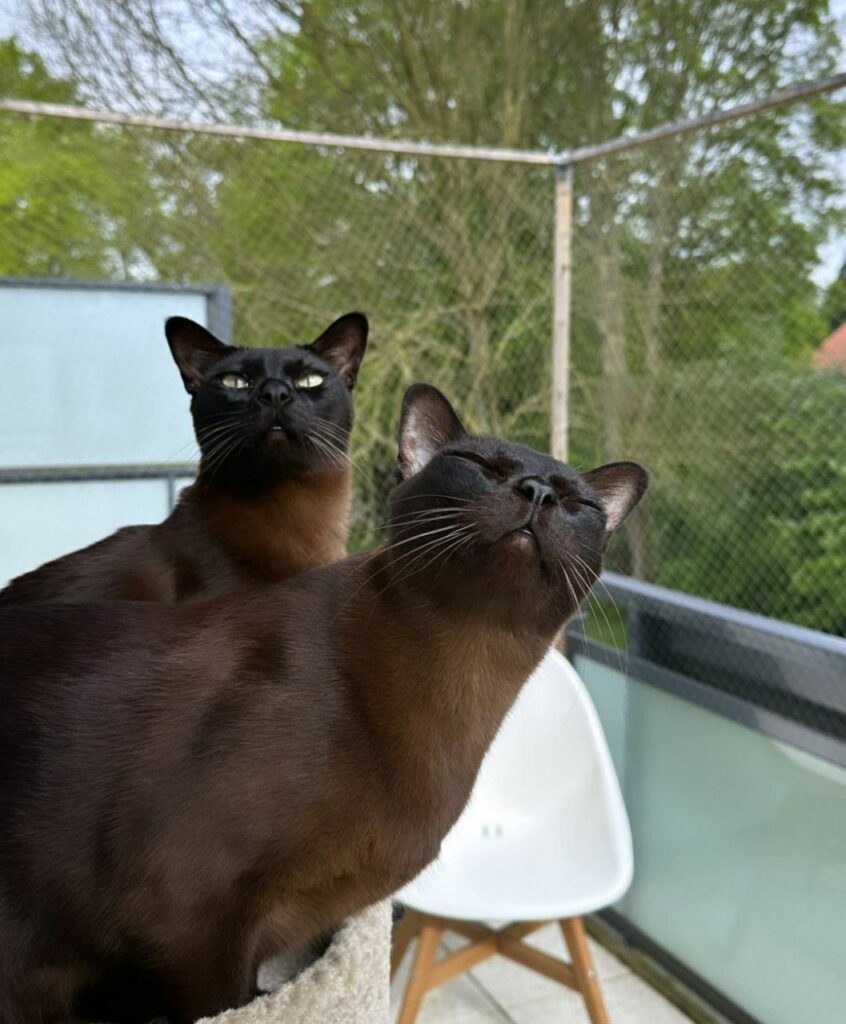Burmese Cats
The Burmese: A Silken Embrace with a Playful Heart
The Burmese cat, with their captivating round eyes, luxuriously soft coat, and playful spirit, embodies the essence of a charming and affectionate companion. Often nicknamed the “Burmie,” these captivating felines with their captivating personalities have stolen hearts worldwide. Delving into the history, characteristics, care requirements, and fascinating facts surrounding the Burmese reveals a breed steeped in mystery and brimming with personality.

A Whispered Past: Unveiling the Burmese’s Origins
Unlike many pedigreed cat breeds with meticulously documented histories, the Burmese’ origin story is shrouded in delightful ambiguity. Local legends from their native Southeast Asia speak of a temple cat, the “Burmese Copper,” with a golden coat and captivating green eyes. These cats were believed to bring good luck and were revered for their gentle nature.
However, historical evidence suggests the Burmese we know today most likely originated in Burma (present-day Myanmar) in the early 20th century. These early Burmese were likely descendants of naturally occurring brown shorthaired cats in the region. In the 1930s, a pair of Burmese cats were brought to the United States, sparking interest in developing the breed outside of Southeast Asia.
Selective breeding programs focused on refining the Burmese’ unique features, such as their round eyes, cobby build, and stunning coat color. However, a lack of genetic diversity in the early breeding pool led to the introduction of Siamese cats to the Burmese breeding program in the 1950s. This resulted in two distinct Burmese types: the “American Burmese,” with a heavier build and a warmer brown coat, and the “British Burmese,” with a sleeker build and a cooler brown shade. Today, both types are recognized by major cat associations, offering a choice for potential owners.

A Coat as Soft as a Whisper: The Burmese’s Distinctive Appearance
The defining characteristic of the Burmese is undoubtedly their luxurious, silky coat. This short, single coat comes in a rich, warm brown shade known as “chocolate.” The Burmese standard emphasizes a uniform color across the body, with minimal shading or tipping. Their eyes, another captivating feature, are large, round, and a striking shade of golden yellow. Their gaze is often described as expressive and intelligent.
Beyond their coat and eyes, Burmese cats are known for their medium-sized, cobby build (American type) or slightly sleeker build (British type). They are muscular and well-proportioned, with broad chests and strong legs. Their heads are rounded with prominent cheekbones and a broad, short nose. Their ears are medium-sized and slightly rounded, completing their overall sweet and charming expression. The Burmese’s overall appearance is one of elegance and softness, accentuated by their luxurious coat and captivating eyes.
A Heart of Gold with a Playful Spirit: The Burmese’s Personality
The Burmese’s temperament is as captivating as their appearance. They are renowned for their intelligence, playful nature, and unwavering loyalty to their humans. Unlike some independent cat breeds, Burmese cats thrive on human companionship and require regular interaction. Their intelligence allows them to be trained with positive reinforcement, and they can even learn tricks like fetching or walking on a leash (with proper harness training).
Their playful spirit often extends well into adulthood, making them delightful companions for those seeking an energetic and interactive feline friend. Burmese cats enjoy games that challenge their minds and bodies, such as chasing feather toys, climbing cat trees, or engaging in interactive play sessions. Their curiosity and devotion to their humans make them a joy to live with, often following their favorite people around the house.
However, their intelligence and energy can sometimes lead to mischief if they become bored. Providing them with enrichment activities like puzzle feeders or rotating toys can help keep them mentally stimulated and prevent destructive behaviors. Burmese cats are generally not recommended for homes with very young children who may not understand their playful nature and need for gentle interaction.


Living with a Burmese:
Here are some additional things to consider when living with a Burmese cat:
Providing Enrichment: Their intelligence and playful nature require mental stimulation. Interactive toys, puzzle feeders, and climbing structures can help keep them engaged and prevent boredom. Consider clicker training to strengthen your bond and provide them with a fun mental challenge.
Accommodating their Playful Side: Schedule dedicated playtime sessions to engage their playful side. Rotate toys to keep things interesting, and use interactive toys that encourage them to chase, pounce, and explore.
Building a Bond Through Voice: Burmese cats are vocal and enjoy conversations with their humans. Talking to them in a gentle, positive voice helps them feel connected and engaged.
Diet: Burmese cats are active and playful, requiring a high-quality cat food formulated for active breeds. Look for formulas rich in protein to support their muscle development and overall health. Regular feeding schedules and monitoring their weight are crucial to maintain optimal health. Burmese cats can be prone to overeating, so portion control is essential.
Veterinary Care: Regular veterinary checkups are essential for all cats, including Burmese. These checkups can help detect potential health issues early on and ensure your feline friend receives the preventive care they need. While generally healthy, Burmese cats can be prone to certain conditions, such as:
Craniofacial Dysostosis (CFD): This is a genetic condition affecting the development of the skull and facial bones. Responsible breeders screen their cats for this condition to avoid passing it on to offspring.
Potassium Deficiency: Burmese cats can be prone to low potassium levels, which can lead to muscle weakness. Veterinarians may recommend dietary adjustments or potassium supplements in some cases.
Progressive Retinal Atrophy (PRA): This is a group of inherited eye diseases that can lead to vision loss. Regular veterinary checkups and genetic testing can help identify potential risks.
Providing a Loving Environment: Burmese cats crave companionship and interaction. Dedicate time for playtime, gentle cuddles (they are known for being lap cats!), and positive reinforcement training to strengthen your bond with your feline friend. Their intelligence allows them to learn tricks and enjoy interactive games, making them engaging companions.
Beyond the Silken Coat: Fascinating Facts about Burmese Cats
The “Talkative Cat”: Burmese cats are known for their vocal nature. They often communicate with their humans through chirps, trills, and meows, conveying their needs and emotions.
A Breed on the Rise: The Burmese’s popularity has steadily grown in recent decades. Their playful personalities, loyal nature, and relatively low-maintenance needs have made them a favorite among cat lovers seeking an affectionate and interactive feline friend.
Famous Fans: The Burmese has garnered a dedicated following, including celebrities like Marlon Brando and Marilyn Monroe who were known to adore these captivating cats.
The “Chocolate Drop”: The Burmese’s rich brown coat color is often referred to as “chocolate,” adding to their luxurious and elegant appearance

The Debate Continues: The American and British Burmese types continue to be a topic of discussion among cat fanciers. Some advocate for merging the two types, while others prefer to maintain the distinction.
Owning a Burmese cat is a truly rewarding experience. Their captivating appearance, playful personalities, and unwavering loyalty make them ideal companions for those seeking an affectionate and interactive feline friend. By understanding their specific needs, providing proper care, and offering them a loving environment, you can ensure your Burmese thrives and brings joy to your life for many years to come. Whether you seek a vocal companion for lively conversations or a loyal playmate for energetic sessions, the Burmese offers a unique blend of intelligence, playfulness, and a heart brimming with love for their humans.

The Victory Of Animal Abusers Over Animal Lovers In Iran
Facebook Twitter Pinterest LinkedIn1. Weaknesses in Legal and Executive Structures: One of the most significant challenges in the field of animal welfare in Iran is

Caring for Senior Dogs: Essential Tips for Keeping Your Aging Pet Healthy and Happy
Facebook Twitter Pinterest LinkedInWhy Senior Dog Care is Different Common Health Issues in Senior Dogs Common Health Problems in Older Dogs As dogs age, just

Effective Weight Management for Dogs: Best Diets and Exercise Tips
Facebook Twitter Pinterest LinkedInWhy Weight Management is Important for Dogs Health Risks of Overweight Dogs Health Risks Associated with Pet Obesity Pet obesity is a


